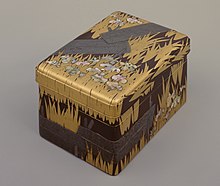| This article needs additional citations for verification. Please help improve this article by adding citations to reliable sources. Unsourced material may be challenged and removed. Find sources: "Raden" – news · newspapers · books · scholar · JSTOR (August 2022) (Learn how and when to remove this message) |




Raden (螺鈿) is a Japanese term for one of the decorative techniques used in traditional crafts and woodwork. It refers to a method of inserting nacre into a carved surface of lacquer or wood. The kanji for ra (螺) means 'shell' and den (鈿) means 'inlaid'. Raden is a term used only for the technique or work of inlaying thin layers of pearl shells. In Japan, the technique of embedding the mother of pearl of shellfish in lacquer is called raden, while the technique of embedding metal or ivory is called zōgan (象嵌).
The term may also be used for similar traditional work from Korea called najeonchilgi (螺鈿漆器), from China called luodian (Chinese: 螺钿), or in countries in South-East Asia such as Vietnam, and for modern work done in the West.
Techniques of production
There are many ways that raden is produced, with all techniques classed under three main categories: atsugai (using thick shell pieces), usugai (using much thinner pieces), and kenma (the thinnest application of shell pieces).
In atsugai raden, the shell is often cut with a scroll saw, then finished with a file or rubstone before application. In usugai raden, the thinner shell pieces are usually made using a template and a special punch. Kenma raden is fashioned similarly to usugai raden.
Methods of application are varied. Thick shell pieces may be inlaid into pre-carved settings, while thinner pieces may be pressed into a very thick coating of lacquer, or applied using an adhesive and then lacquered over. Other methods use acid washing and lacquering to produce different effects.
Raden is especially combined with maki-e – gold or silver lacquer sprinkled with metal powder as a decoration.
History
The basic technique of raden originated in Egypt around 3500 BC, and the technique spread along the Mediterranean coast. There is a theory that the technique of raden in the East was introduced from Persia in the Sasanian dynasty to China, and another theory that it started in the Yin dynasty, and the former theory is now widely accepted. By the Tang dynasty, the technique, known in Chinese as luodian, had reached a very mature level, especially lacquer-backed luodian on bronze mirrors, which was a treasure of craftsmanship in this period. Bronze mirrors with luodian lacquer backs have been excavated from Tang tombs in Shanxian County and Luoyang, Henan Province.
The basic technique of luodian was introduced from the Tang dynasty into Japan during the Nara period, where it is referred to as raden, using the same Chinese characters. In Japan, raden had been used in combination with Japanese various maki-e techniques since the Heian period, but raden declined in the Muromachi period.
From the Sengoku period to the Azuchi-Momoyama period, many Japanese lacquerware decorated with maki-e and raden attracted European people, and were exported through the Nanban trade via Portuguese and Spanish in response to the request of the Society of Jesus. Raden was often used in the creation of European-style items, such as chests of drawers and coffee cups, and was very popular in Europe, as the mother-of-pearl covering the items contributed to their status as a unique luxury. The Japanese referred to these goods as "Nanban lacquerware", with Nanban meaning "Southern Barbarians", a term borrowed from the Chinese and, in 16th century Japan, meaning any foreigner, especially a European.
In the Edo period, many pieces of Japanese lacquerware were exported to royalty and nobility in Europe through Dutch East India Company and private traders. The lacquerware exported during the Edo period put more emphasis on artistic expression by maki-e using gold powder lavishly than raden. Until the 1690s, the Dutch East India Company monopolized the export of Japanese lacquerware throughout Europe, but the lacquerware using maki-e technique using a large amount of gold was so expensive that the customers were limited to royalty and nobility, and after 1690, it was exported through private trade.
After the Opening of Japan to foreign trade in the 1850s, raden work for export markets soon became significant again. The Somada style and Shibayama style lacquerware using the raden technique became popular and were exported in large quantities from Yokohama to Europe and the United States. Somada ware is a style invented by Somada Kiyosuke in the 1670s, and is characterized by a regular pattern made of a combination of lacquer, finely cut shellfish, gold leaf and silver leaf. Shibayama ware is a style invented by Shibayama Senzo in the 1770s, characterized by the inlay of various materials such as shellfish, gold, silver, ivory, coral, tortoise shell, and ceramics.
The raden works of a number of famous Edo period craftsmen are still celebrated, namely those of Tōshichi Ikushima, Chōbei Aogai, and the Somada brothers. Raden is widespread in Japan today, and is made for many applications, modern and classic.
See also
References
- ^ Raden. Encyclopædia Britannica
- "Lacquered Comb Box Inlaid with Mother-of-pearl". National Museum of Korea. Archived from the original on 2020-02-21. Retrieved 2024-07-10.
- 故宫博物院词条:螺钿
- ^ Kotobank. Raden. The Asahi Shimbun.
- Masayuki Murata (2020) Kiyomizu Sannenzaka Museum Masterpieces (清水三年坂美術館名品選) p.71. ISBN 978-4-9908614-1-4
- Masayuki Murata. 明治工芸入門 p.24. Me no Me, 2017 ISBN 978-4907211110
- Urushi once attracted the world urushi-joboji.com
- ^ 蒔絵や螺鈿の技法美 世界に広めた漆器類 歴博で特集展. Asahi shimbun. 20 January 2021
- Yūji Yamashita. 明治の細密工芸 pp.60-61. Heibonsha, 2014 ISBN 978-4582922172